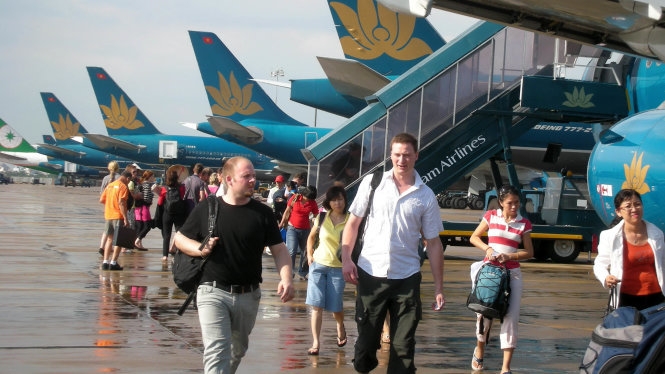Free trade pact facilitates foreign investment in Vietnam’s aviation industry
Opportunities are also open more for foreign investors in the Vietnamese aviation sector as the foreign ownership cap in Vietnamese air transport businesses will be loosened to 34% from the current 30% from early next year.
Vietnam’s commitment to open the aviation sector for foreign investment under the Comprehensive and Progressive Agreement for Trans-Pacific Partnership (CPTPP) is providing foreign investors with opportunities in this industry.
| Vietnam permits foreign investment in all air services. |
According to Nguyen Thi Thu Trang, director of the Vietnam Chamber of Commerce and Industry’s WTO Center and Integration, under the CPTPP, Vietnam has permitted foreign investment in the aviation sector, including local and international air services, through capital contributions or stake acquisitions, for the first time.
By allowing foreign investors to make capital contribution and share purchase of a domestic airline, Vietnam has opened the aviation sector and permitted foreign investment in all air services that a Vietnamese airline is allowed to provide, including cargo and passenger transport activities.
“The commitment is very open as Vietnam has yet to permit foreign investors to offer air transport services under the World Trade Organization and the European Union-Vietnam Free Trade Agreement,” Trang noted.
The investment, however, will have to meet certain restrictions, including a 30% cap on foreign ownership in an airline. Further, the largest shareholder in an airline must be a Vietnamese individual or organization, two-thirds of the board members of a foreign-invested carrier must be Vietnamese nationals and the general director and legal representative of the carrier must be Vietnamese nationals.
Opportunities are also open more for foreign investors in the Vietnamese aviation sector as Prime Minister Nguyen Xuan Phuc has recently signed a government’s decree to increase the permitted foreign ownership in Vietnamese air transport businesses to 34% from the current 30% from early next year.
With the goal of reducing and simplifying business conditions and creating favorable conditions for investors to access the aviation market, the new decree also regulates that an air transport business operating 10 aircraft or fewer will need to have a minimum capital, including ownership capital and loan, of VND300 billion (US$12.9 million). Businesses operating from 11 to 30 aircraft will need minimum capital of VND600 billion (US$25.64 million), while those with more than 30 aircraft, the required minimum will be VND700 billion (US$29.91 million).
Huge incentive
With high growth potentials in Vietnam’s aviation industry, demand for development and investment in the next five years will be a large incentive for foreign businesses to invest and seek co-operation.
Trinh Nhu Long, deputy director general of Vietnam Air Traffic Management Corporation (VATM), said that VATM will pour around US$500 million into dozens of key projects from now to 2025, so international biddings will be carried out to select investors or suppliers of these projects.
Vietnam's aviation is one of the fastest-growing markets in the region and the world. Over the past five years, the volume of passenger transportation has been increasing by 10 million arrivals annually, equivalent to an increase of 170% as compared to 2014.
The market is forecast to continuously grow further with a rate of 10% per year. It is expected that the total volume of passengers will reach 131 million in 2020, and 280 million in 2030, while it is approximately 90 million this year.
There are 67 international airlines and six local airlines flying hundreds of routes from Vietnam's 22 airports. To meet the current and future development needs, Vietnam plans to finish building Long Thanh international airport and extend several others.
Accordingly, the numbers of international airports will be raised to 28 by 2030, and local airport to 15 by 2030 from 13 currently.












